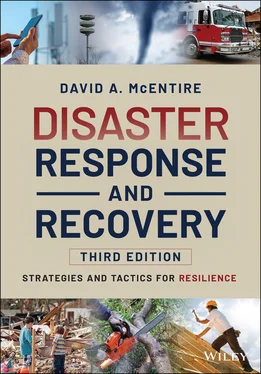David A. McEntire - Disaster Response and Recovery
Здесь есть возможность читать онлайн «David A. McEntire - Disaster Response and Recovery» — ознакомительный отрывок электронной книги совершенно бесплатно, а после прочтения отрывка купить полную версию. В некоторых случаях можно слушать аудио, скачать через торрент в формате fb2 и присутствует краткое содержание. Жанр: unrecognised, на английском языке. Описание произведения, (предисловие) а так же отзывы посетителей доступны на портале библиотеки ЛибКат.
- Название:Disaster Response and Recovery
- Автор:
- Жанр:
- Год:неизвестен
- ISBN:нет данных
- Рейтинг книги:5 / 5. Голосов: 1
-
Избранное:Добавить в избранное
- Отзывы:
-
Ваша оценка:
- 100
- 1
- 2
- 3
- 4
- 5
Disaster Response and Recovery: краткое содержание, описание и аннотация
Предлагаем к чтению аннотацию, описание, краткое содержание или предисловие (зависит от того, что написал сам автор книги «Disaster Response and Recovery»). Если вы не нашли необходимую информацию о книге — напишите в комментариях, мы постараемся отыскать её.
The new edition of the standard textbook in the field, updated with new studies and practical guidelines for reacting to the complexities of today’s disasters Disaster Response and Recovery: Strategies and Tactics for Resilience
Disaster Response and Recovery: Strategies and Tactics for Resilience, Third Edition
Disaster Response and Recovery — читать онлайн ознакомительный отрывок
Ниже представлен текст книги, разбитый по страницам. Система сохранения места последней прочитанной страницы, позволяет с удобством читать онлайн бесплатно книгу «Disaster Response and Recovery», без необходимости каждый раз заново искать на чём Вы остановились. Поставьте закладку, и сможете в любой момент перейти на страницу, на которой закончили чтение.
Интервал:
Закладка:
These groups are not without potential drawbacks, however. The populace may have no formal disaster training. They may unintentionally injure those victims they are trying to help (e.g., by making mistakes when providing basic first aid). Emergent groups may also get in the way of professional responders as they go about their duties. Emergent responders may even create unique challenges for emergency managers. For example, after Hurricane Andrew, there were so many donations in terms of food and supplies that it was difficult for organizations to distribute the aid efficiently. Successful response and recovery operations require the harnessing of emergent groups while simultaneously minimizing any potential negative impact.
Self‐Check
What are emergent groups and why do they form after a disaster?
Are emergent groups beneficial or detrimental? Explain your reasoning.
How is a “mass assault” different than an “altruistic community?”
What can be done to utilize emergent groups effectively?
2.5 Working with All Partners and the Whole Community
As an emergency management official, you must be aware how each of the agencies, organizations, groups and individuals interact during disasters. Thy myriad of people and organizations involved in disasters can be viewed holistically by means of a well‐known disaster organizational typology (Dynes, 1970) (see Figure 2‐9). This model was developed by scholars from the famous Disaster Research Center (DRC) at Ohio State University (now located at the University of Delaware). For this reason, it is called the DRC typology. Its purpose is to help scholars and practitioners comprehend the unique characteristics of organizations that engaged in activities during and after disasters.
The DRC typology was developed by Russell Dynes and E.L. Quarantelli upon interviewing hundreds of people and practitioners who observed disasters or were involved in emergency management. These researchers categorized prior findings based on two dimensions and produced a fourfold typology of organizational involvement in disasters (Dynes, 1970; Quarantelli, 1966). The two dimensions of the model are tasks and structures.
Tasks refer to the activities of the organization. This may include functions that are routine (common to the organization) or non‐routine (unfamiliar to the organization). Structures refer to the organization’s relationships and longevity. The organizational structure may be old (implying that it existed before the disaster) or new (suggesting that it was created after the disaster). Each type of organization has unique characteristics. For instance:
Established organizations are groups that perform routine tasks with existing structures. A fire department falls under this category. A fire department existed before the disaster and it fulfills fire suppression functions on a daily basis.
Expanding organizations are groups that perform routine tasks with new structures. The Red Cross falls under this category. Its diverse workers from around the country are sent to a disaster site, but they still complete their normal responsibilities.
Extending organizations are groups that perform non‐routine tasks with existing structures. A possible example of this type of organization is a church. The pastor and congregation take new on duties but were familiar with one another prior to the disaster.
Emergent organizations are groups that perform non‐routine tasks with new structures. Citizens who were strangers prior to a disaster fall into this category (e.g., if they are completing unfamiliar search and rescue activities for those injured in an earthquake).
The DRC typology should be considered as a useful heuristic tool for those involved in response and recovery operations. This model underscores the fact that there are many groups that participate in emergency management activities and that they each have distinct backgrounds, different goals, unique experiences and varying lengths of existence. For these reasons, coordination among the various groups may be hindered and organizational conflicts or problems may occur. As an example, a fire department and police department may have an existing interagency rivalry (due to budgetary competition within a city), which may adversely affect cooperation in a disaster. Or it is possible that some nonprofit organizations may not wish to work with other humanitarian agencies in order to better highlight their individual accomplishments in a disaster.

Figure 2‐9 Disaster organizational typology
For Example
International Actors
Disasters are not just domestic issues. They also affect all countries, although developing nations are especially vulnerable. For this reason, governments around the world have endorsed the United Nations International Strategy for Disaster Reduction. A number of individuals, agencies, countries, and international organizations are also involved and assist with mitigation, preparedness and humanitarian response, and recovery operations. Here is a small sample:
AmeriCares
Bill and Melinda Gates Foundation
Canadian International Development Agency
Direct Relief International
Doctors Without Borders
International Federation of Red Cross and Red Crescent Societies
International Relief Teams
Office of Foreign Disaster Assistance (United States Agency for International Development)
OXFAM
Pan American Health Organization
REACT International
Samaritan’s Purse
United Nations Office for the Coordination of Humanitarian Affairs
World Emergency Relief
World Health Organization
World Vision

https://www.usaid.gov/who‐we‐are/organization/bureaus/bureau‐democracy‐conflict‐and‐humanitarian‐assistance/office‐us
The Office of Foreign Disaster Assistance, a unit within the Agency for International Development in the State Department, provides relief to nations who have been affected by disasters.
However, it should be noted that the DRC typology has implications beyond theoretical descriptions of values and operational priorities. As an example, established organizations will most likely be aware of each other (e.g., the head of Public Works will know peers in the Environmental Department). This familiarity may facilitate collaboration. Nevertheless, and in contrast, people in expanding organizations and emergent groups may have never interacted before, and this limits the communication that could occur across agencies and volunteers. Furthermore, an established organization most likely needs to follow strict laws and policies when it is performing the functions it has been assigned, and this fact may cause those affiliated with the organization to avoid interaction or have conflicting relations with emergent groups. For instance, an official search and rescue team may not want to have ordinary people involved in this activity due to liability concerns. Alternatively, those working in an existing business may know one another, but they may lack any expertise in disaster issues. This situation could cause others involved in emergency management to view them with suspicion or question their capabilities.
Knowing these sorts of interorganizational dynamics can help you better recognize potential problems in response and recovery operations and take measures to overcome them. With improved understanding of all of the actors involved in disasters, you will be able to harness and harmonize the interaction among them based on their unique skills and abilities. And this collaboration is a major principle in emergency management (Kapucu 2015; Sobelson et. al. 2015; Dee 2014). In fact, FEMA’s “ Whole Community” concept acknowledges that a “government‐centric approach to emergency management” is not sufficient to deal with disasters. All of the available resources must be collectively utilized at each level of government and within and across communities to prepare for and react to such an incident. Improved response and recovery operations will likely occur when all individuals and agencies fulfill individual roles and work collaboratively on responsibilities that span distinct organizational domains. Therefore, the important point to remember is that, everyone figuratively and literally deserves a “seat at the table” when you are trying to coordinate post‐disaster operations (Robinson and Gerber, 2007).
Читать дальшеИнтервал:
Закладка:
Похожие книги на «Disaster Response and Recovery»
Представляем Вашему вниманию похожие книги на «Disaster Response and Recovery» списком для выбора. Мы отобрали схожую по названию и смыслу литературу в надежде предоставить читателям больше вариантов отыскать новые, интересные, ещё непрочитанные произведения.
Обсуждение, отзывы о книге «Disaster Response and Recovery» и просто собственные мнения читателей. Оставьте ваши комментарии, напишите, что Вы думаете о произведении, его смысле или главных героях. Укажите что конкретно понравилось, а что нет, и почему Вы так считаете.












